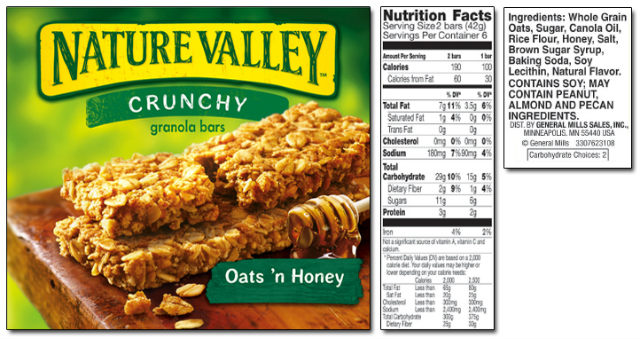
In 1975, Nature Valley introduced the granola bar. The initial reception was lukewarm as granola was seen as a “fringe” food. Shortly thereafter in the mid-1980s, Power Bar introduced the first “energy bar,” which was designed for endurance athletes like marathoners and distance cyclists. Power Bar, while popular, was also seen as a niche food intended for elite athletes.
Little did Nature Valley and Power Bar know that they had started a massive trend in the way we consume food. The convenience and portability of such products quickly caught on. If you’ve ever tried lugging a peanut butter and jelly sandwich on a 26-mile run, long bike ride, or all-day hike, you know the transportability of many foods can be problematic. Things like sandwiches tend to get messy or are hard to consume while moving.
With such convenience coupled with the war on fat and focus on calories, the bar revolution was born.
But are these “healthy” foods actually healthy for us to consume?
And are they even what they say they are?
Let’s look deeper at what has become a daily staple for many of us — and at how we might be doing our health a great disservice.

The Birth of the Bar
As consumers have become collectively heavier and sicker (and, ostensibly, busier), they’ve increasingly demanded healthier fast-food options. Consequently, the nutrition and fitness industries have embraced the quick, easy, and “healthy” mantra. Bars, shakes, and supplements are now a nutritional mainstay for many of us. But, without question, the darling of “healthy” packaged food is the bar.
Instead of being a fringe food for hippies, athletes, and astronauts, bars have become “meal replacements” for everyone. Entire new categories have been created, from the “nutrition” bar to the “diet” and “weight-loss” bar. Today, you can hardly find a grocery store, convenience store, or gas station that doesn’t have a section dedicated to the almighty bar.
In 2016 alone, sales of nutrition bars resulted in profits that totaled over $2.2 billion. Most consumers haven’t given this a second thought, as bars tend to get the intended job done — they are convenient, portable, and (nowadays) pretty tasty. We’ve come a long way since those original Power Bars.
But any food that comes in a package also carries with it a shadow side.
The Obesity Epidemic
An interesting parallel trend also started in the mid ‘70s to early ‘80s — the obesity epidemic. The percentage of America’s overweight and adult population had been essentially unchanged from 1900 to 1980. This despite massive changes in the way people moved and lived. Instead of working in factories and agriculture, people worked at desks. People moved their bodies less as a means of transportation and drove more. Technology like the TV and computer meant people increasingly sat more. On the food front, fast food had become increasingly popular and the hamburger and fries became a main staple of the American diet.
Yet, none of these trends correlated to our populace getting heavier.
That all changed in a decade, from 1975 to 1985, Why?
The one-word answer is “sugar.”
And the four-word answer is “packaged and processed foods,” which started to be consumed en masse during the ‘80s. People began passing over “real” foods like bananas, eggs, and broccoli for sugar cereals, TV dinners, and boxed cookies — not to mention bars, shakes, and protein cookies. This global trend of massive processed food consumption continues to this day.

Candy Bar or Nutrition Bar?
Granted, a nutrition or energy bar is not exactly a candy bar and not all bars are created equal. But you wouldn’t necessarily discern that from the sugar content and when you’re trying to navigate the savvy marketing of the food industry.
I once worked at a gym where we sold an energy bar made with “real” Reese’s Pieces and Oreos. And take a quick look down that convenience store aisle and you’ll see flavors that include brownie, mint chocolate and creamy vanilla. The assertion is obvious: “You can have your cake and eat it, too.”
In addition to high sugar content, one of the knocks on bars has been the common laundry list of ingredients. In response, bars such as Lara Bar and RXbar have touted their products as lower-ingredient, healthier options. To be sure, these products bars are better choices than many of their counterparts. But, regardless of their ingredients, bars by definition are a packaged and processed food and when push comes to shove, they aren’t designed to be a large part of our daily nutrition.
Eating bars and similar meal replacements as a nutritional approach is simply problematic for several reasons.
The Role of Sugar in Our Mortality
First, though diets based on bars and shakes have been popularized as a convenient avenue to health and weight management, it isn’t working as a long-term solution as evidenced by the latest obesity, life expectancy statistics. Furthermore such a quick fix focus is misguided as the calorie is not the primary culprit of ill health or weight gain, despite the massive amount of negative attention it receives. In fact, a recent major study that appeared recently in JAMA concluded diet quality was the major factor in long-term well-being and controlling weight, not calories.
It isn’t simply added calories that are the problem but added sugars in our food supply. Added sugars are associated with cardiovascular disease (CVD), mortality, and obesity. According to JAMA, “Consumption of added sugar, including all sugars added in processing or preparing foods, among Americans aged 2 years or older increased from an average of 235 calories per day in 1977-1978 to 318 calories per day in 1994-1996.”
Added sugars now make up at least 10% of daily caloric consumption for the average American. Of note, roughly one in ten people get a staggering one-quarter or more of their calories from added sugar. That same study went on to conclude, “Most US adults consume more added sugar than is recommended for a healthy diet. We observed a significant relationship between added sugar consumption and increased risk for CVD mortality.”
So, despite what you see on The Biggest Loser and no matter how much weight a person might lose eating fake food, in the long run, weight management is less a function of calories and more a function of the quality of our food.
It isn’t just the JAMA study that suggests focus on food quality and the consumption of real foods. Countless other references, studies such as those cited in everything from Fat Chance, Blue Zones, and The China Study corroborate the fact that nutrient-rich diets (based on whole and/or raw foods) that are lower in sugar content correlate directly to lower mortality and less disease. Furthermore, studies have determined that adults who eat whole foods experience less depression versus those who eat a diet high in processed foods. Studies also show it takes our bodies longer to digest processed foods.
Question Everything: Even Your Snack Bar
Many bars are laden with extensive amounts of additives or sweeteners, which may be obvious or presented as “healthy” in the form of dates, rice syrup, and a bevy of other ingredients. Yet another problematic factor is that (according to the FDA) terms like “natural” are not regulated for food products, so essentially a company can promote their products as healthy just by putting such eye-catching buzzwords on the package.
We must always keep in mind that packaged foods are designed to get us to want them and keep buying them — not necessarily to make us healthier.
And because of the way these bars are constructed, many of us purchase them thinking we are doing something “good” for ourselves. Then, we eat them like candy all day every day and can’t seem to figure out why we never get full, can’t keep weight off, and can’t get the proper nourishment our body needs.
While much of the blame in the added sugar in our diets is related to sweetened beverages, we also have to take a hard look at processed and packaged foods like bars. Simply put, the notion that optimal health, performance, and/or weight management is a function of giving up unhealthy packaged and processed foods in favor of “healthy” packaged foods is a flawed strategy.
Real Food Is the Better Answer
Food in a box or a bag is not the answer to our health and weight woes. Real foods are.
As the saying goes, food is your medicine and the basis of your nutrition shouldn’t come in pills, potions, or packages. Food is meant to be perishable, whole, and naturally nourishing to the body. Period.
Far too many of us allow marketing tactics and convenience to dictate what goes into our mouths. Just because a package tells us it’s healthy, organic, or promotes fitness and wellness, doesn’t mean it’s true. It’s time for us to eat a lot less processed food, including foods like bars that are labeled “good” for us.
Bars are not meant to be a main staple of your diet. Rather they are meant to be occasional substitutes for the rare times when real food is not available. Do yourself a favor and save the bars for where they were originally intended — the occasional fifty-mile bike ride or on the chairlift when you’re skiing.
Featured Image: “Protein Bars Anyone?” (CC BY 2.0) by Robert Stinnett
Obesity Vs. Sugar Intake Chart Source: Johnson RJ, et al. Potential role of sugar (fructose) in the epidemic of hypertension, obesity and the metabolic syndrome, diabetes, kidney disease, and cardiovascular disease. The American Journal of Clinical Nutrition, 2007.
